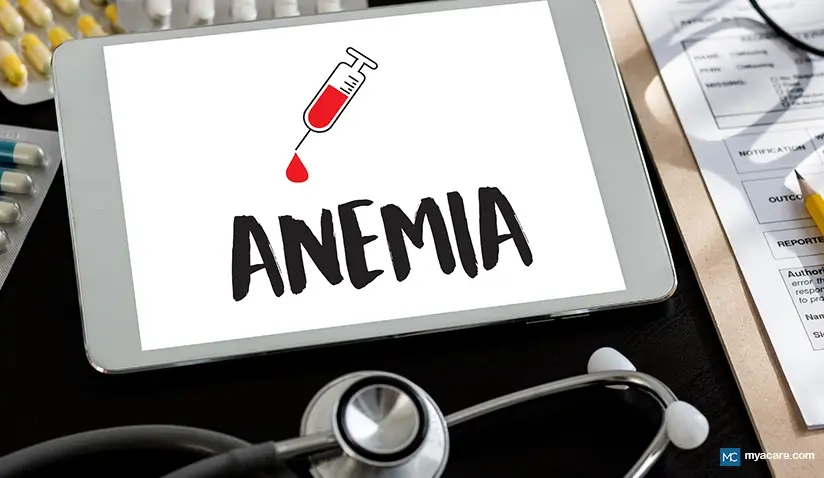What Is Anemia?

Anemia is a condition where your red blood cells cannot carry sufficient oxygen to the cells of the body. This anemia definition is general and the exact nature of the problem depends on what the cause is. Read further to learn about the different types of anemia, symptoms, causes, and how the condition can be treated.
Types of Anemia
There are many types of anemia. Regardless of what kind of anemia a person has, it will adversely affect the blood. These different types of anemia are described below.
What is Sickle Cell Anemia?
Sickle cell anemia is a type of anemia caused by an inherited gene mutation, where the hemoglobin is malformed causing the red blood cells (erythrocytes) to take on odd shapes. This prohibits the cells from passing through the small blood vessels of the body.
What is Iron Deficiency Anemia?
Iron deficiency anemia is the most common form of anemia and is caused when a person does not have enough iron in the blood. Iron is essential because it binds the oxygen atoms to the red blood cells. Each red blood cell contains hemoglobin which is a combined protein and iron molecule. Poor diet and heavy menstruation can cause iron deficiency anemia.
What is Aplastic Anemia?
Aplastic anemia is an uncommon condition in which the bone marrow does not produce sufficient numbers of red blood cells. Radiation and toxins can cause aplastic anemia by damaging the bone marrow. This in turn results in problems with hematopoiesis (blood cell formation).
What is Hemolytic Anemia?
Under normal conditions, old and worn-out red blood cells are destroyed by the spleen. In hemolytic anemia, too many erythrocytes are destroyed too quickly compared to the numbers that are formed. Hemolytic anemia can be a result of an autoimmune reaction or a reaction to a medication such as quinine. Infectious organisms can also cause premature hemolysis of erythrocytes.
What is Pernicious Anemia?
Vitamin B12 is essential in making red blood cells in our body. Pernicious Anemia is caused due to vitamin B12 deficiency, leading to lack of production of the red blood cells. Pernicious anemia is rare in the general population. It is due to an autoimmune condition where a substance in the stomach called intrinsic factor is not made. This intrinsic factor is needed to absorb the B12, which means that even if the person is eating food containing this vitamin, it is not absorbed.
Anemia Symptoms
There are certain signs of anemia that you should be aware of. Some additional symptoms occur with certain kinds of anemia. General symptoms of anemia are given below, as well as the extra signs of certain forms of anemia.
- Fatigue
- Dizziness
- Lightheadedness
- Shortness of breath
- Pale skin
- Hands and feet feel cold
- Pain in the chest
- Irregular heartbeat
- Yellow tint to the skin (jaundice) (hemolytic anemia)
- Extreme pain in joints, chest and abdomen that may last from hours to days at a time (sickle cell anemia)
- Unexplained bruising (aplastic anemia)
- Headache (pernicious anemia)
- Pins and needles sensation (pernicious anemia)
What Causes Anemia?
Anemia can be caused by many factors. The possible causes are listed and described below.
- Diet: A lack of iron in the diet can cause anemia, so it is important to follow a balanced diet.
- Menstruation: Heavy periods can cause iron deficiency anemia.
- Bleeding from the gastrointestinal (GI) tract in the digestive system: A person may bleed from the stomach or intestines if they have a problem like an ulcer or inflamed bowel. This can also result in anemia.
- Genetics: If a child inherits the sickle-cell allele from both parents they will develop sickle-cell anemia. Thalassemia is another inherited disorder that causes anemia because with this condition too little hemoglobin is formed in the body.
- Autoimmune disease: Problems with the immune system can result in some types of anemia.
- Toxins and radiation: Destruction of the bone marrow has severe consequences since this is the site of blood cell formation. Certain medications can adversely affect the bone marrow.
How is Anemia Diagnosed?
Blood tests can often detect anemia. Certain features noted in the blood sample will indicate a problem, for instance:
- A low hemoglobin level (below 13g/dL for males and below 12g/dL for females)
- A decreased hematocrit (decreased percentage of red blood cells in the blood; below 41% for men and below 36% for women)
- Low platelets (also known as thrombocytopenia, below 150,000 per microliter of blood)
- The presence of aberrant hemoglobin (in the case of sickle cell disease the hemoglobin has valine instead of glutamate present in the molecule)
How is Anemia Treated?
Anemia treatment methods depend on the underlying cause. How to treat anemia depends on what type it is. Below are some of the treatment options:
- Iron supplements: Iron supplements are helpful for iron deficiency. The dosage may be as follows:. In general, adult males, post-menopausal women, and children require 10mg a day of iron while pre-menopausal women need 20mg of iron a day. Please consult your doctor before taking the supplements as dosage may vary depending on your health condition.
- Dietary changes: People may need to alter their diet to include iron-rich foods. Red meat, spinach, and legumes are some foods high in iron content.
- Vitamin B12 injections: This is needed for those with pernicious anemia.
- Bone marrow transplant: This is a treatment often used in severe aplastic anemia cases.
- Pain relief and oxygen therapy: Patients with sickle-cell disease are often in a lot of pain and oxygen and medication helps relieve their discomfort.
- Blood transfusion: This can help sickle cell patients and also those who have lost blood due to a GI tract bleed.
Can Anemia be Cured?
It may be possible to cure anemia depending on the type, however, in some cases, such as sickle cell disease, the anemia can only be managed.
Conclusion
Anemia can be due to many factors. It can have a debilitating effect on the body and may be fatal in some cases. Correct diagnosis and treatment are important in anemia. Treating anemia is important in helping improve the overall quality of life.
To search for the best healthcare providers worldwide, please use the Mya Care search engine.

Dr. Rae Osborn has a Ph.D. in Biology from the University of Texas at Arlington. She was a tenured Associate Professor of Biology at Northwestern State University, where she taught many courses to Pre-nursing and Pre-medical students. She has written extensively on medical conditions and healthy lifestyle topics, including nutrition. She is from South Africa but lived and taught in the United States for 18 years.
Sources:
Featured Blogs



